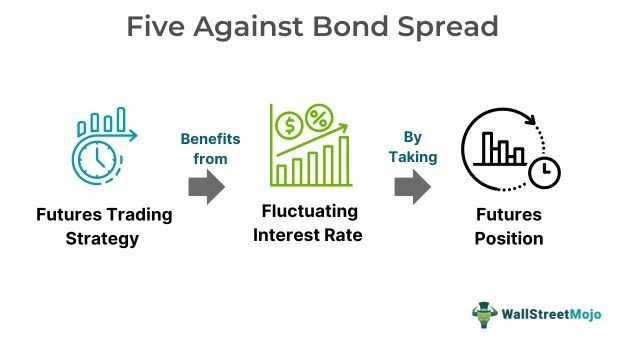Table of Contents
What Is Five Against Bond Spread (FAB)?
A Five Against Bond Spread (FAB) refers to a strategy of futures trading that tends to gain from the difference between the differing maturity treasury bonds through obtaining offsetting positions concerning futures contracts. It benefits traders anticipating interest rate movements along the yield curve amongst differing maturity treasury bonds.

It applies to long-term treasury bonds having 15–30 years of maturity and 5-year treasury bonds. FAB creation results from selling futures contracts on long-term treasury bonds and buying one on five-year treasury notes, or vice versa. FAB remains one of the yield curves or spread trading strategies used in treasury markets.
Key Takeaways
- A five-against bond spread (FAB) is a futures trading technique that seeks to profit from the disparity in maturities of treasury bonds by holding offsetting holdings of futures contracts.
- These affect FAB - bond credit quality, interest rate changes, maturity risk premiums, yield curve, inflation, investor risk aversion, yield spread, and future cash flows.
- It advantages traders who anticipate interest rate moves along the yield curve for government bonds of varying maturities.
- A variety of factors like U.S. economic health inflation expectations, interest rates, Federal Reserve policies, and bond yields impact the FAB approach.
How Does Five Against Bond Spread Work?
Five Against Bond Spread is a strategy of trading used to benefit from the fluctuating interest rate by taking a futures position. This is either short or long in a 5-year treasury, followed by adopting the opposite position in a 15-year- or 30-year version. Such a strategy leverages the perceived deviations of pricing within the treasury market. Further, it also signals that a trader utilizes a variation of the yield curve where the discrepancy between long-term and short-term bond yield may not reflect accurate future interest rates.
Its working has the basis that differences in pricing in the spreads tend to revert or normalize eventually, as represented through the futures contract prices along the treasury yield curve. As a result, traders profit by setting positions alongside futures as per their movement of treasury. Different elements like the inflation outlook, the U.S. economic strength, interest rates, Federal Reserve actions, and bond yields influence the FAB method. The said strategy has been an essential part of a diversified trading portfolio.
Investors can trade futures contracts using different treasury securities comprising 2 or, -5 or -10- or 30-year maturities, having contracts traded as precise small tick sizes. It proves highly beneficial to traders with in-depth knowledge of technical and economic elements affecting the treasury market. It has manifold effects on the financial world, as it aids in predicting a country's economic conditions. Moreover, the strategy's foundation, yield spreads, indicates a lot about investor sentiments related to economic health. Hence, the strategy has become a crucial tool to get correct indications of the economy.
Factors
It's a known fact that FAB strategy depends on five-year treasure notes positions made to offset 10-year treasury notes positions. Hence, any change in bond spread affects FAB as below:
- Bond credit quality plays an important role in ascertaining bond alpha in a portfolio.
- Any change in interest rate affects the yield spread amongst bonds with different maturities.
- A debt security with the same maturity and different credit quality gives certain differences in yields.
- Any yield spread creates awareness about market sentiments at times of widened yield spreads.
- Long-term debt often becomes riskier than short-term debt because of maturity risk premium.
- The yield curve directly impacts Fab because it shows the interconnection between bond maturities and related yields.
- Inflation impacts the future cash flows due to eroded purchasing power, leading to less attractiveness in long-term bonds.
- When investor risk aversion increases by ten, it drives the treasury yields down, resulting flattened curve. Hence, it influences FAB spread.
Examples
Let's use a few examples to understand the topic.
Example #1
A report published in a leading journal on November 2023 on understanding the crucial role of a 5-year treasury in FAB strategy. The research focused on the cornerstone level importance of the 5-year treasury bond inside the U.S. treasury curve. Further, it highlights its impact on shaping interest rate anticipation and market volatility. The study also highlighted the dominance of 5-to-10-year treasury yields, underscoring the liquidity, transmission role, and size in sharing crucial information throughout the interest rate framework.
The study has also brought forth the influence of the 5-year treasury on the market of treasury derivatives, along with its extensive evaluation of treasury bond yields. Hence, the report has laid stress on the importance of 5-year treasury in gaining in-depth insights into wider market implications.
Example #2
Suppose that the Old York Exchange now has a $2 price spread among Old York Treasury bonds based on the June cycle. In the above scenario, an investor using the FAB strategy may take advantage of the price disparity by selling or acquiring Old York Treasury bonds having five-year maturity. Therefore, the investor might make money from the price disparity and the five-year bond's effect on interest rate expectations. They can do so by utilizing the five-year treasury's critical holding in the U.S. yield curve.
Hence, the example shows how trades might use the FAB technique in a real-world financial setting to their advantage. Further, using the dynamics of the market and the interaction of Treasury bond yields, they can even use it to generate profits possibly.
